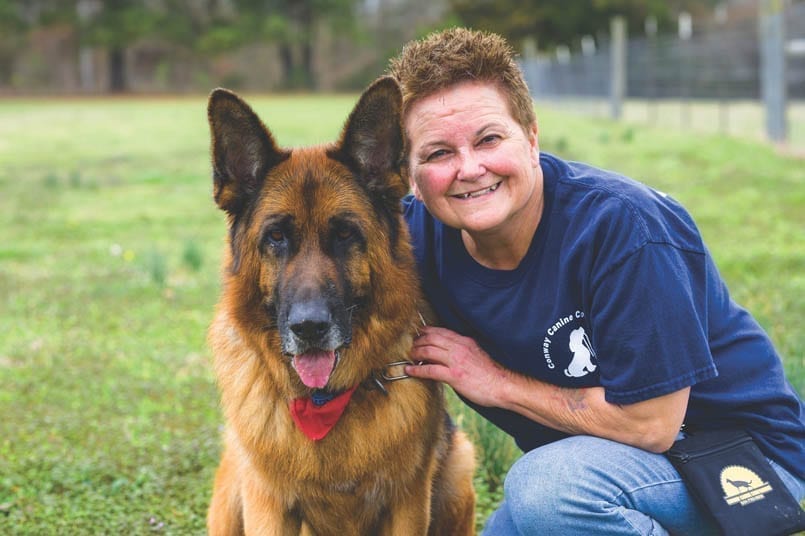30 Mar 2021 Raise the woof: Conway trainer develops dogs into better companions
By Dwain Hebda
For as long as she can remember, Pamela Padgett has owned and loved dogs. And for all of that time, she’s been trying to find a way to understand what makes them tick.
“I’ve always been fascinated by dogs and by dog behavior,” said the Army vet and career anesthetist. “The scientific principles of dog behavior are what I find so interesting — that we can actually do things to effect change without having to use the old–school methods of jerking up on the leash or using an aversive method. We can use positive reinforcement and train.”
About 12 years ago, Padgett decided to start training dogs professionally, a move that would lead her to found her business, Conway Canine Companions, four years later. She said she was moved to launch the business after noticing a gap in the local market.

“There are many training facilities out there and individuals who still used these old–school methods that, frankly, are pretty aversive,” she said. “We had our local pet stores that offered some training, but that was kind of just something extra that they added. They didn’t have anybody solely committed to training right here in Conway.”
Among the services Padgett offers through her business, and arguably the one closest to her heart, is training therapy dogs, of which she has owned two herself. She said therapy dogs are a growing presence in society as they can serve humans in a variety of situations.
“The world now is so sped up and stress–ridden that we see the benefit of just being able to cuddle and snuggle a sweet animal,” she said. “It’s been long–known, the advantages of just doing that. It lowers your blood pressure, lowers your heart rate, lowers your stress level. Those are all great things.
“Compared to other parts of the world, we’re a little slow to the game. In other countries, the dogs are more a part of their lives. But we’re starting to see, and have really embraced, how dogs help our lives.”
Today, therapy dogs are at work in nursing homes and health care facilities to comfort patients. They’re often seen in classrooms from kindergarten to college campuses to help reduce stress. You can even find therapy dogs at some airports to help stressed–out travelers get centered, or they may visit a school after a tragedy such as a school shooting or a suicide to help students cope.
“I’ve taken one of my big German shepherds to an elementary school in Little Rock and did a presentation for some fourth graders,” Padgett said. “I’ve done a stint with the local Girl Scout organization, helping them earn badges with my dog.
“Therapy Dogs International even has a subset, a smaller unit called Tail–Wagging Tutors, where dogs are trained to sit and listen to a child read to them. It’s been shown that students who have trouble reading, if they read out loud, they get better. But it’s embarrassing, I mean, kids can be brutal. Dogs are nonjudgmental. You can sit in the corner of the library and read out loud to the dog and the dog just loves it.”
Despite seeing more instances of these dogs being deployed, Padgett said people still confuse therapy dogs with service animals, or use the term interchangeably.
“A service dog has to perform some function for a disabled human and they have to do that with some sort of behavior,” she said. “They are specifically trained to smell the ketones on the breath for diabetic alert dogs, to assist during a seizure, to assist during a panic attack. The dog can’t just be present, the dog actually has to function and perform a task.
“Then, there’s the emotional support animal, which is essentially a dog that’s present because I’m too anxious to be in the situation without him. That requires special certification from a mental health provider.”
“Then, there are therapy dogs,” Padgett said. “That’s the one that’s most common. Therapy dogs work with their owner and then they go and provide a service to others, not the owner.”
Padgett’s therapy dog training is a six–week class, but a dog’s total education could take six months or more depending on how green the animal is on prerequisite obedience skills and socialization. Once through with classes, the dog is tested to receive its credentials as a therapy dog. Padgett said the work is well worth it in the end.
“I had a client once, an older woman, who actually took pictures of my dog and had them in her little apartment,” she said. “My dog got so excited every time we pulled into that driveway to visit. The lady would just sit back and she wanted to hold the leash and she wanted to pet her with her cane. Landry was a big German shepherd, she was like, ‘Pet me with your cane. I don’t care.’
“When I first got into it and I took my very first dog to my very first place for a visit, I thought I was doing it for other people. What I found is that my life was so busy that it was kind of nice for me, too. I looked forward to the visits because I could sit for an hour, or an hour and a half, and just talk to these people in the nursing home and let them love on my dog.”
- The pinnacle of success - June 1, 2025
- Five-Oh-Ones to Watch 2025: Aaron Farris - December 31, 2024
- Julia Gaffney brings medals and mettle home to Mayflower - October 30, 2024








